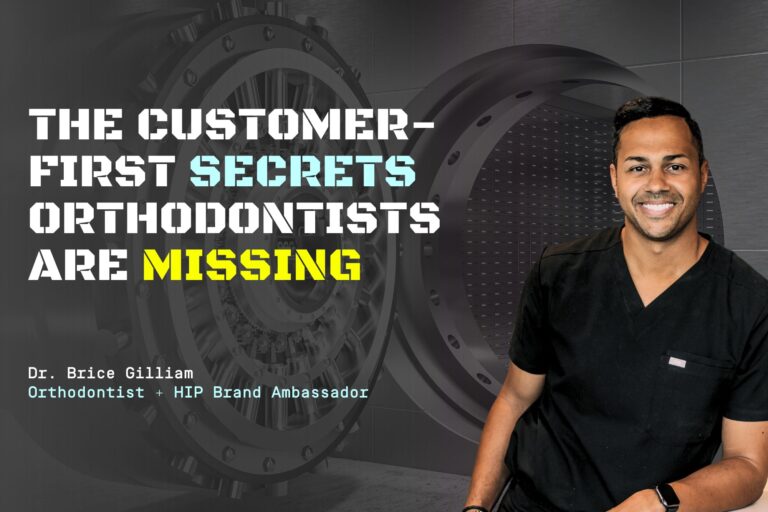Many people will never forget the life-changing confidence boost they got the day their braces were removed. If you haven’t had that experience yourself, surely you know someone who has. After all, in the United States alone, over 4 million people are wearing braces right now. And over 50% of US-born children will have braces before adulthood.
With all that built-in demand, orthodontics is a growing field where doctors can do very well — so maybe you’re wondering how to become an orthodontist.
Becoming an orthodontist takes a decade or more of study and major financial investment. So you don’t want to commit to it without a clear idea of what you’re getting yourself into. That’s why we put together this guide. Keep reading to discover exactly what it takes to become an orthodontist and get some tips to set yourself up for a successful career.
FREE BOOK: Orthodontic Secrets
What Is an Orthodontist?
An orthodontist is a dental professional trained to diagnose, prevent, and treat dental and facial irregularities. The most common issue orthodontists address is malocclusion, an issue with how teeth are aligned and fit together, otherwise known as the “bite.”
An orthodontist’s expertise extends beyond general dental care to include aligning teeth, correcting bite issues such as overbite or underbite, and enhancing the aesthetics of a patient’s smile.
Compared to general dentists, orthodontists complete years of specialized education and training focused on the mechanics of tooth movement and facial development. Their extensive training qualifies them to handle complex dental problems that require precision and expertise.
What Do Orthodontists Do?
Orthodontists use specialized tools and appliances such as braces, retainers, and aligners to move teeth into their proper positions. For example, they might design a treatment plan to fix a teenager’s overbite using metal braces or recommend clear aligners for an adult who is embarrassed by their crooked smile (but also embarrassed to wear metal braces).
Orthodontic treatments are not simply cosmetic. Orthodontists play a crucial role in improving oral health by correcting issues with proper chewing and speaking. They can also fix jaw alignment issues, alleviate debilitating jaw pain, and improve long-term dental health by positioning teeth for optimal cleaning and maintenance. As an orthodontist, you’ll work closely with each patient to understand and design individual treatment plans to resolve their issues.
How Long Does It Take to Become an Orthodontist?
The process to become an orthodontist will generally take 10-11 years after high school. You’ll need to attend four years of college, then another four years of dental school. And then you’ll have to complete two years of residency. Along the way, you’ll also need to pass several licensing and board certification exams.
The process requires specialized training and a significant time commitment. But, according to Indeed.com, the average orthodontist’s salary is just over $270,000 per year — so the investment of time and money can pay off with a fulfilling, successful, and profitable career!
In this article, we’ll give you a comprehensive roadmap on how to become an orthodontist. Together, we’ll review the education, training, and skills you’ll need to be successful, so you can decide if it’s the right career path for you.
The Steps to Becoming an Orthodontist
Your path to becoming an orthodontist often starts early — even before you start college. Let’s take a look at the steps you’ll need to take to get there.
1) Start Planning Early
The journey towards becoming an orthodontist can begin as early as high school. If you’ve already decided to pursue a career in orthodontics, focus on science and mathematics courses like biology, chemistry, physics, and calculus in high school. Because building a solid base of knowledge in the sciences will help you build a knowledge base and way of thinking you’ll need when studying more complex sciences in college and dental school.
2) Get an Undergraduate Degree
You’ll typically need a four-year undergraduate degree to get admitted to any dental school. To maximize your chances of being accepted, opt for a science-related field. Biology, chemistry, physics, and mathematics courses are commonly part of the admission prerequisites. Focus on achieving a strong GPA and gaining experience through internships or volunteering in dental clinics to boost your chances of getting into your preferred dental school
3) Pass the Dental Admission Test (DAT)
Before applying to dental schools, you must pass the Dental Admission Test (DAT). It’s a standardized exam assessing scientific knowledge, academic capacity, perceptual ability, and understanding of fundamental principles relevant to dental studies. Study hard for this one because a competitive score on the DAT is crucial for admission into the best dental programs. And while you can be a successful orthodontist graduating from any dental school, a degree from a well-renowned school will make your road a bit easier.
4) Attend Dental School
Once admitted to dental school, you’ll enter a four-year program leading to a Doctor of Dental Surgery (DDS) or Doctor of Medicine in Dentistry (DMD) degree. You’ll get classroom and clinical training in general dentistry, anatomy, physiology, pharmacology, and other dental-related subjects. You’ll also get hands-on experience in various dental specialties through rotations and patient care. You’ll leave dental school with a well-rounded knowledge of dentistry before laser-focusing your attention on orthodontics in residency.
5) Get Your Dental License
After graduating from dental school, you must obtain dental licensure before entering an orthodontic residency. Your dental license allows you to practice general dentistry, so you’re now officially a dentist! Your journey to becoming an orthodontist isn’t over yet, but from here forward, you’ll finally dedicate all your time to studying and perfecting the science of orthodontics.
NOTE: Requirements and examination formats vary between states, so it’s essential to review the specific criteria for the jurisdiction in which you plan to practice. Start by checking out the ADA’s interactive licensure map, but confirm with a lawyer or local professional organization to be sure you complete all the necessary steps.
6) Complete an Orthodontic Residency
Following dental licensure, you’ll need to pursue a 2-3 year residency in an accredited orthodontic program. This specialized training offers hands-on experience and advanced studies in orthodontics, including diagnosis of malocclusion, treatment planning, and appliance therapy.
Admission to top orthodontic residency programs is highly competitive, requiring strong academic performance, letters of recommendation, and an interview process. Focus on building a strong resume while in undergrad and dental school. Because by the time you’re applying for residency, it’s too late to start taking the process seriously.
7) Get Board-Certified
Though it’s not mandatory, many orthodontists choose to become board-certified by the American Board of Orthodontics. You’ll need to pass written and clinical examinations administered by the American Board of Orthodontics to become board-certified. Board certification boosts your credibility and helps earn the trust of potential patients. The seal of credibility can be a difference-maker, especially if you plan to launch your own private practice.
8) Get Your State License
To practice as an orthodontist in a specific state, you must meet the state’s licensure requirements for orthodontic specialists, which differs from your dental license. You’ll need to submit to additional examinations, background checks, and verification of education and experience. Again, requirements vary by jurisdiction, so it’s essential to consult with your state’s dental board or licensing agency to understand the exact steps.
9) Continue Professional Development
Congratulations — after 10 to 12 intense years of study and practice, you’re now a board-certified and officially licensed orthodontist!
But your education doesn’t stop here. You’ll have to keep up-to-date with industry trends, new technology, and emerging treatments. Ongoing continuing education through workshops, dental conferences, professional networking, and accredited courses is necessary to ensure you provide the highest quality care and acquire the business skills you’ll need to build a successful career in orthodontics.
FREE BOOK: Orthodontic Secrets
What Does an Orthodontist Need to Be Successful?
You’ll need a wide range of skills, ranging from clinical knowledge to interpersonal skills and business savvy, to become a successful orthodontist. Some of these skills you’ll learn in school, but others you’ll need to acquire through external training, networking, and mentors or coaches. Here’s an overview of the skillset of a well-rounded orthodontist.
Technical Skills
You’ll need to develop and hone your clinical skills to make you a superior orthodontist. Being able to help your patients improve their lives is your #1 responsibility. These are skills you’ll learn in school. But you’ll continue improving and perfecting them throughout your career. These technical orthodontic skills include:
- Orthodontic treatment planning
- Orthodontic appliance selection
- Advanced dental anatomy
- Manual precision and dexterity
- Use of orthodontic technology
Interpersonal Skills
Being a successful orthodontist is about more than just clinical skills. It depends on your ability to connect with people. As you work toward your orthodontics career, you should develop strong interpersonal skills too. It will help you provide better care for your patients and work more effectively with your team. Here are some ways in which your interpersonal skills are essential for an orthodontist:
- Understanding your patient’s needs
- Fostering teamwork within the practice
- Delegating and managing effectively
- Keeping up with technological advances
- Building your professional network
Your technical and interpersonal skills work together to create the essential toolkit for an orthodontist. Cultivating these abilities will enhance your competence as a doctor and enable meaningful connections with your patients and colleagues.
How to Become a Successful Orthodontist
Simply becoming an orthodontist is a significant achievement. But how well you leverage your skills and training will determine your level of success in the field. You can put your skills to work for yourself by building a private practice or choosing to be a critical contributor to a practice that’s already successful.
There are several different paths that can help you become a successful orthodontist. Which path to take will depend on your personality, clinical preferences, and the type of work you’d like to do. Let’s take a look at the most common routes to orthodontic success:
Work for an Existing Private Practice
Joining an established private practice allows you to focus on patient care without the added stress of managing a business. You’ll benefit from leveraging the existing processes, team dynamics, and built-in patient base of the orthodontist that owns the practice.
As an employee-orthodontist, you’ll probably earn a salary for your work instead of a share of the profit, which limits the amount of money you can make. But it’s often a good choice that new orthodontists can use as a stepping stone to hone their clinical skills, practice patient skills, and learn what it takes to be a successful orthodontist.
Work for a Corporate Ortho Practice
Increasing numbers of orthodontists will work for corporate orthodontic chains directly out of residency. Working in a corporate practice gives you even more structure, resources, and opportunities for collaboration than in private practice. The emphasis on standardized procedures can offer stability and support as you focus on improving your clinical skills early in your career. If you aim to be a successful orthodontist without the burden of administrative responsibilities, this could be your path.
Start Your Own Private Practice
Starting your own practice is the pathway with the most significant potential reward. Still, it also comes with the highest risk, stress, and anxiety. As an owner, you’ll determine the clinical focus, office culture, and growth strategy for your practice. However, it requires significant investment, business acumen, and resilience. If you dream of running the show and growing aggressively, this path is for you. But it will require careful planning and execution and learning a new skill set: running a successful business.
Partner with a Corporate Practice
Partnering with a corporate practice combines aspects of private and corporate dentistry. You may enjoy the entrepreneurial benefits of owning a practice with the support and resources of a larger organization. This collaboration can mitigate some risks and administrative burdens, allowing you to focus on what you love most — helping patients achieve beautiful smiles. But it’s probably not an option for you straight out of residency.
Each of these options can help you become a successful orthodontist. So think about your career goals, appetite for risk, and lifestyle preferences to help you choose the path that fits your idea of success.
FREE BOOK: Orthodontic Secrets
Building a Successful Orthodontic Practice
Becoming a business owner by starting a new orthodontic practice, or buying an existing practice, can be the most rewarding experience for an orthodontist. And that’s especially true if you want to grow your income and build a career that fits your lifestyle.
But building a successful orthodontic practice takes much more than the clinical skills you’ll pick up in dental school or residency. To build a thriving business, you’ll need strong leadership skills and a solid grasp of business principles. And those are things that dental schools and residency programs don’t teach.
Running an orthodontic practice isn’t just about fixing cases of malocclusion. You’ll also need a strategic growth plan, a compelling marketing plan, community engagement, and efficient business operations for everything from lead generation to patient exams.
Building a fast-growing orthodontic practice with multiple offices and regional dominance is the dream of many future orthodontists. But when it’s time to go for it, we’d recommend engaging with an orthodontic consultant or an orthodontic growth partner, like HIP, ensuring you set up your practice for immediate success.
So You Want to Be an Orthodontist…
Someday, maybe you’ll be the one that inspires your own patients to pursue a career in orthodontics. After all, we often hear stories from orthodontists who chose their profession after a life-changing experience as a teenage patient.
If you want to become an orthodontist, we’ve shown you the roadmap here above. It’s a journey filled with dedication, learning, challenges, and immense rewards. But at the end of the road, you’ll find financial stability and the unique opportunity to change lives for the better. It’s a worthwhile road for many, but only you can decide if it’s the right one for you!










